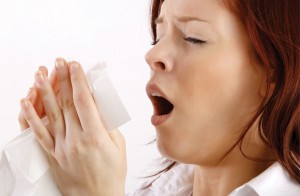By Daniel N. Tucker, M.D. –
 South Florida’s humidity, warm temperatures and climate is a “Petri dish” for mold colonization. Our climate makes those suffering from a mold allergy feel tired, and often times miserable. Asthma, Allergic rhinitis (hay fever symptoms), chronic/recurrent sinusitis, skin problems (including hives), migraine headaches, chronic fatigue, food allergies, are just of few illnesses that frequently include a strong mold allergy. Some suffering the above illnesses/symptoms have been told they have no allergies and their disease is idiopathic or intrinsic – meaning the doctor does not know the cause of illness. Mold allergies often go undiagnosed or misdiagnosed. Courses of antibiotics, cortisone, and various other drugs are often prescribed and can make patients more vulnerable to illness and recurrent symptoms. If you suspect a mold allergy seek out an allergist who is knowledgeable in mold species, growth characteristics, seasonal incidence and circumstances under which mold exposure can occur.
South Florida’s humidity, warm temperatures and climate is a “Petri dish” for mold colonization. Our climate makes those suffering from a mold allergy feel tired, and often times miserable. Asthma, Allergic rhinitis (hay fever symptoms), chronic/recurrent sinusitis, skin problems (including hives), migraine headaches, chronic fatigue, food allergies, are just of few illnesses that frequently include a strong mold allergy. Some suffering the above illnesses/symptoms have been told they have no allergies and their disease is idiopathic or intrinsic – meaning the doctor does not know the cause of illness. Mold allergies often go undiagnosed or misdiagnosed. Courses of antibiotics, cortisone, and various other drugs are often prescribed and can make patients more vulnerable to illness and recurrent symptoms. If you suspect a mold allergy seek out an allergist who is knowledgeable in mold species, growth characteristics, seasonal incidence and circumstances under which mold exposure can occur.
A commonly used allergy test the “Prick Test” is a great diagnostic tool in detecting many allergies, but misses many mold allergies. Determination of mold allergy often requires further, more extensive testing.
Once a mold allergy has been diagnosed, treatment must be tailored to the individual based on the nature of their illness/symptoms and the fungal agent causing it. The terms mold, mildew, and fungi are to a large degree interchangeable in understanding allergy symptoms and treatment. Fungi cause diseases in all life forms including animals, humans, and virtually all plant types. Because they have no chlorophyll, molds, cannot make their own food from the basic elements. Instead they use powerful enzymes that convert both live and dead matter into basic chemicals they can use. These enzymes can themselves be allergens as well as cause illness by attacking our living tissues. Many molds produce toxins (mycotoxin), as well and may suppress immune systems.
Our warm moist climate encourage mold and mildew growth. Other important factors are oxygen availability, acidity or alkalinity of the site, and availability of minerals. Mold can grow in cooler environments, as I am sure you have seen on the forgotten leftovers in the refrigerator but cooler temperatures and lack of moisture discourage mold growth. Mold commonly attacks building materials, insulation, lumber, as well as leather, stored food, and both natural and synthetic fibers. Mold can even grow on materials that are considered hypoallergenic (including latex), and various materials in pillows and mattresses. Along with dust mite debris, mold and mildew can make up the allergic reaction associated with bedding materials. Many who think they are just allergic to dust are also reactive to mold antigens.
While we can’t eliminate mold from our environment completely, environmental controls can dramatically reduce symptomology of those suffering. All areas of the home should be inspected for mold and mildew, closets, bathrooms, and behind kitchen cabinets are particularly likely spots for growth. Inspect your home for leaks – not just in the roof; also check all plumbing and air conditioner condensation. Use Air conditioner filters that are rated for allergic households, these have screens that filter out small mold spores. Change these as the manufacturer recommends. Ultra violet lights in the air conditioner system itself are very helpful in mold control. Properly maintain your air conditioning system and keep it set at a low temperature. Make sure not to turn the thermostat up at night or when away, this will only allow for mold growth. Keep the humidity below 60. A free standing air cleaning system such as HEPA can reduce antigen exposure at both home and in the office. Use measure aimed to control dust mites, this also aids in mold control: use allergy proof/mite proof covers for pillows, mattresses/
box springs, and comforters, and vacuum all carpets and drapery weekly.
Some individuals benefit from dietary controls. A diet low in fungal antigens avoids products that are fermented and simple carbohydrates (sugar and other high glycemic index foods). This approach requires medical monitoring since a diet too restrictive can create additional health problems. Many mold sensitive people are also affected by gluten/gliaden containing foods and dairy products.
If you have experienced unresolved symptoms of asthma, allergic rhinitis (hay fever symptoms), chronic/recurrent sinusitis, skin problems (including hives), migraine headaches, chronic fatigue, food allergies seek out an allergist who has knowldege about mold allergies. Mold allergies can be treated when properly diagnosed. Suffering is not the only option.
Daniel N. Tucker, M.D., PA
Fellow, American Academy of Allergy, Asthma, and Immunology Fellow American College of Allergy, Asthma, and Immunology Diplomate, American Board of Allergy/Immunology Anti-Aging Medicine and Pathfinder Programs
Call Today:561-835-0055
1411 North Flagger Drive, Suite 6700
(in Victor Farris Building)
West Palm Beach, Forida 33401
Check Also
RejuvaNATION MedSpa: Elevating Men’s Health to New Heights
Embark on a Journey to Revitalize Your Vitality Rediscover the joy of a spontaneous sex …
 South Florida Health and Wellness Magazine Health and Wellness Articles
South Florida Health and Wellness Magazine Health and Wellness Articles




